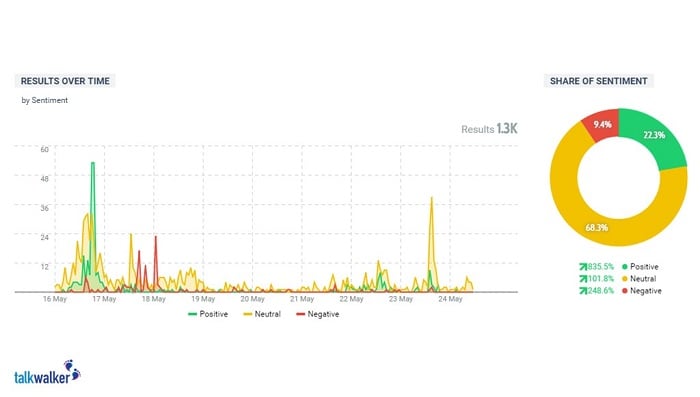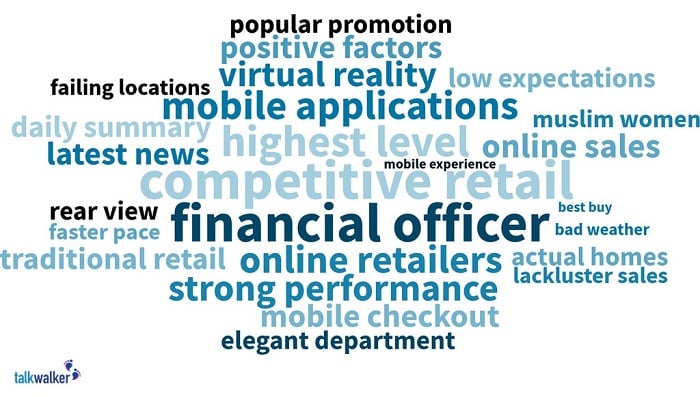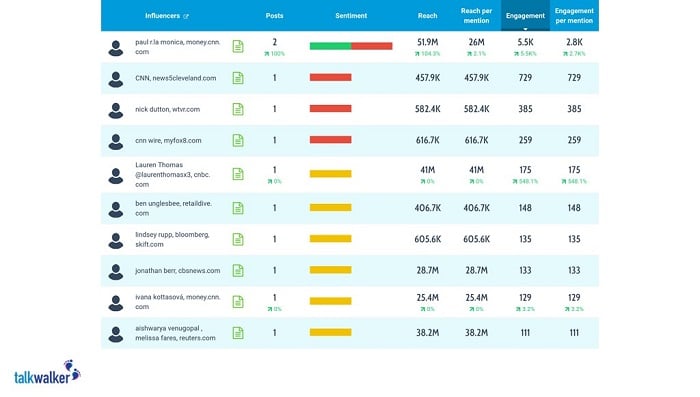Monitor my earnings call impact
What is an earnings call?
An earnings call is a quarterly or fiscal yearly conference call. It allows company management to discuss financial results with investors, analysts, and media. These are often webcast, or recorded and distributed online to allow access for all relevant people.
The problem for PR personnel is that it’s one huge news drop. Along with the supporting earnings report, it releases a lot of private information into the public domain. Such as income statements, financial statements, balance sheets, and earnings per share, plus CEO analysis & industry trends.
How you manage this is down to your preparation. You need to handle the messaging of your release efficiently. Then monitor and gauge how that messaging has been picked up and diffused by the press.
Step 1. Drive your PR narrative
To see what’s possible when creating your earnings conference call messaging, let's look at a recent successful one.
Macy’s most recent earnings announcement was on May 16, and with impressive results, it gained a lot of media mentions.
But that success was also down to how the company shaped their success narrative. One thing CEO Jeff Gennette emphasized was, "This is the most competitive retail environment I've ever seen." This phrase was quoted time and again, as the brand positioned themselves not just as a success, but a success in a difficult climate. This will pay off in the long term when the press compares Macy’s story to their competitors’ (as discussed below).
Remember, no matter your results, your earnings call is your opportunity to tell the story you want. Therefore, the correct preparation of your narrative is key.
Step 2. Monitor your earnings call
Once you have shaped your story, you need to monitor how news sources retell it. You need to know if the messages you delivered are being picked up, so you can react accordingly. And if not, why not.
To monitor an earnings call through social listening, you need to create a Boolean that incorporates all the keywords relating to it. The more detailed the keywords you track, the more accurate your monitoring will be.
Name and misspellings
You want to search for all online mentions of your brand name. And any misspelled mentions, or ones that suffered from fat-fingered typing. With a query like this:
![]()
That will find all the mentions for the brand.
Related keywords and people
You also want to add in a few terms that may come up in press articles, like the New York Stock Exchange shortcode (NYSE:M) and business personnel (like CFO Karen Hoguet and CEO Jeffrey Gennette).

Topic keywords
Now, you have to ensure the data relates to what you need it for. Since the May 16, there are over 48.7k mentions of the above query. You need to add some keywords to pinpoint the results.
There are 2 ways to do this. First, You can add phrases that relate to an earnings call…

That way, you only find mentions that include Macy’s (or related spellings/phrases) and earnings call (or related phrases).
The other option is to search for your topic keywords near keywords that you would expect to come up in earning call new articles.

The NEAR Boolean searches for mentions of Macy’s near finance related phrases. (The financ* keyword will search for phrases such as finance, finances, financial and similar).
This gives us 1.3k results since May 16. All related to the earnings conference call.
Remember, the Boolean you use for your monitoring is just as important as your form 10-k (the annual report legally required in the US). Ensure it’s set-up and accurate in plenty of time before your earnings call happens.
Step 3. Reshape the narrative based on your results
Initially, look at the sentiment analysis of your results. This gives you a general overview of how well received your earnings call was.
In Macy’s case, you get this:

Overall, the earnings release was positive, with a peak of positive mentions straight after. But you need to dig deeper.
What’s working
Look at what the themes relating to your positive mentions are. This theme cloud shows the main messages that were diffusing in the press content during that week.

There’s that ‘competitive retail’ phrase mentioned earlier, incorporated in 15% of mentions. Once you have shaped your narrative, you can see how that story is shared.
You can also look for new stories. The rollout of their virtual reality furniture shopping featured in 10.3% of the mentions. This is something Macy’s could look to promote further in the future, as it gained some PR traction.
Another element you should monitor, is how your content is being engaged. By looking at your major influencers, you can see which news outlets generated the most engagement. That way you can see which demographics are engaging, and which you need to target more with your PR efforts. In this case, it’s clear the message engaged the relevant financial investors, via Money.cnn.com.

What’s not working
Though generally positive, there were still reports such as this one from Morningstar. It focused less on short-term gains, and more on long-term recuperation.
By looking at results like these, you can engage that negativity, and work on PR efforts to tackle it. You can also check out the article’s virality to see how well it traveled (in this case it was only shared in the relevant newspaper, and one tweet). That way you know where to target your PR efforts to mitigate potential damage.
Another cause of negative mentions was due to Macy’s inclusion in press related to JC Penney’s earnings call on May 17. In reports of JC Penney’s suffering, the press referenced Macy's as a successful example.
Due to timing, and engaging with the right topic (in this case, weather), Gennette was often quoted in articles related to JC Penney. Ensuring your earnings call is relevant, covers trendings topics and is easily quotable, encourages news outlets to share it, even beyond your own PR efforts.
It doesn’t stop with your own earnings call
Now you know how to monitor your earnings call impact, and how to handle the PR afterward, don’t stop there.
You can use these same techniques to monitor the impact of your competitors’ calls too. This helps you get a better understanding of what messages your market relates to, and helps you get a better overview of your consumer marketplace.
There’s more on how to conduct competitor analysis here.
Earnings calls - prep, monitor, manage
And that’s the secret to managing your earnings call. Prepare yourself with a good Boolean, measure all that's said about your brand, and then manage the press messages that arise.
It isn’t rocket science, but it will certainly stop it blowing up in your face.
To find a better way to monitor what is being said about your brand (for earnings calls, and all year round), request a free demo below.




